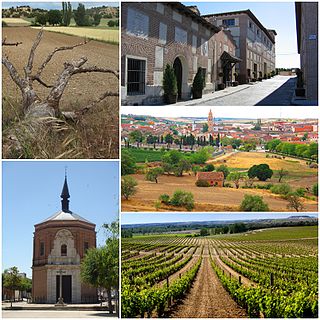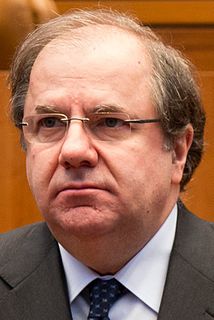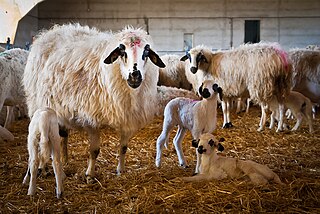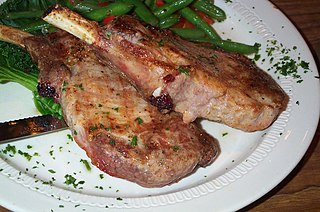
Castilla–La Mancha is an autonomous community of Spain. Comprised by the provinces of Albacete, Ciudad Real, Cuenca, Guadalajara and Toledo, it was created in 1982. It is bordered by Castile and León, Madrid, Aragon, Valencia, Murcia, Andalusia, and Extremadura. It is one of the most sparsely populated of Spain's regions. Albacete is the largest and most populous city. Its capital city is Toledo, and its judicial capital city is Albacete.

Valladolid is a province of northwest Spain, in the central part of the autonomous community of Castile and León. It has a population of 526,223 people in a total of 225 municipalities, an area of 8,110 km2 and a population density of 64.88 people per km2.
The denominación de origen is part of a regulatory classification system used primarily for Spanish wines but also for other foodstuffs such as cheeses, condiments, honey, and meats, among others. In wines, it parallels the hierarchical systems of France (1935) and Italy (1963), although Rioja (1925) and Jerez (1933) preceded the full system. In foods, it performs a similar role, namely regulation of quality and geographical origin among Spain's finest producers. There are five other designated categories solely for wine and a further three specifically covering food and condiments, all recognised by the European Union (EU). In Catalonia, two further categories – labelled A and Q – cover traditional Catalan artisan food products, but were not recognised by the EU as of 2007. In recent decades, the concept of the denominación de origen has been adopted by other countries, primarily in Latin America.

Palencia is a city south of Tierra de Campos, in north-northwest Spain, the capital of the province of Palencia in the autonomous community of Castile and León. The municipality had a population of 78,892 in 2017.

The Sayaguesa is an endangered Spanish breed of domestic cattle. It is named for the comarca of Sayago in the province of Zamora, in the western part of the autonomous community of Castile and León, and is raised almost exclusively in that area. It may also be known as the Zamorana, the Moles de Sayago or the Castellana variedad Sayaguesa. It was traditionally kept mainly for draught work, but is now raised principally for meat.

Lechazo is a Spanish dish made from "cordero lechal". The meat used is from unweaned lambs, and is similar to veal, or the meat of "cochinillo". The province of Castile and León has a distinctive version of lechazo referred to as "Lechazo de Castilla y Leon". It is one of the most important dishes of the cuisine of the province of Valladolid. Also, Aranda de Duero is known as the heart of the dish, with numerous restaurants that specialize in lechazo and feature "hornos de leña", or wooden stoves, in which the lamb is roasted.

The region of León or Leonese region is a historic territory defined by the 1833 Spanish administrative organisation. The Leonese region encompassed the provinces of Salamanca, Zamora, and León, now part of the modern Spanish autonomous community of Castile and León. As is the case with other historical regions, and continuing with centuries of history, the inhabitants of the Leonese region are still called Leonese. Even today, according with official autonomous government, the historical territorial adjective is used in addition with the modern annexed territory, the rest of Old Castile, being "Castilians and Leonese".

The 2011 Castilian-Leonese regional election was held on Sunday, 22 May 2011, to elect the 8th Cortes of the Autonomous Community of Castile and León. All 84 seats in the Cortes were up for election. The election was held simultaneously with regional elections in twelve other autonomous communities and local elections all throughout Spain.

Beher and also called Bernardo Hernández, is a Spanish ham producer company that has worldwide fame. It is situated in the town of Guijuelo, in the Protected Designation of Origin (PDO) Jamón de Guijuelo. This third generation family company was founded in the 1930s and is now one of the 300 biggest companies in Castile and León.

The gastronomy of the province of Valladolid comprises the meals, their preparation, and the culinary habits of the province of Valladolid. Of all the cuisines of the community of Castile and León, it is the most common. it is based on barbecued and roast food, especially roasted Spanish cuisine. Wines of high quality highlight the meals.

The 2015 Castilian-Leonese regional election was held on Sunday, 24 May 2015, to elect the 9th Cortes of the Autonomous Community of Castile and León. All 84 seats in the Cortes were up for election. The election was held simultaneously with regional elections in twelve other autonomous communities and local elections all throughout Spain.

The 2007 Castilian-Leonese regional election was held on Sunday, 27 May 2007, to elect the 7th Cortes of the Autonomous Community of Castile and León. All 83 seats in the Cortes were up for election. The election was held simultaneously with regional elections in twelve other autonomous communities and local elections all throughout Spain.

The Junta of Castile and León is the governing and administrative body of the Spanish autonomous community of Castile and León and serves as the executive branch and regulatory authority. It comprises the President of the Junta, the vice-presidents and the ministers (consejeros). The function of the Junta is to govern and administer the autonomous community.

Pablo Fernández Santos is a Spanish politician, procurator in the Cortes of Castile and León and member of Podemos.

The 2019 Castilian-Leonese regional election will be held on Sunday, 26 May 2019, to elect the 10th Cortes of the Autonomous Community of Castile and León. All 81 seats in the Cortes will be up for election. The election will be held simultaneously with regional elections in eleven other autonomous communities and local elections all throughout Spain, as well as the 2019 European Parliament election.

The Fifth Herrera Government is the incumbent regional government of Castile and León led by President Juan Vicente Herrera. It was formed in July 2015 after the regional election.



















